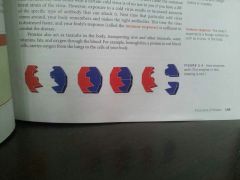![]()
![]()
![]()
Use LEFT and RIGHT arrow keys to navigate between flashcards;
Use UP and DOWN arrow keys to flip the card;
H to show hint;
A reads text to speech;
22 Cards in this Set
- Front
- Back
- 3rd side (hint)
|
Protein |
Major structural parts of the body's cells that are made of animo acids assembled in chain. Rich in animal foods. |
|
|
|
Amino acids |
The building blocks of protein |
|
|
|
Essential amino acids |
Amino acids that either cannot be made in the body or cannot be made in the quantities needed by the body; must be obtained in foods. |
|
|
|
Nonessential amino acids |
Amino acids that can be made in the body |
|
|
|
Deoxyribonucleic acid (DNA) |
Molecules in the nucleus of cells that carry your genetic information. |
|
|
|
Genes |
A tiny section of DNA that has a code to make proteins and other components |

|
|
|
Complete proteins |
Food proteins, generally animal proteins that provide all the essential amino acids in the proportions needed by the body. |
|
|
|
Incomplete protein |
Food proteins that contain at least one limiting amino acid (less one or more essential amino acid) |
|
|
|
Limiting amino acid |
An essential amino acid in lowest concentration in a protein that limits the protein's usefulness unless another food in the diet contains it. |
|
|
|
Complementary proteins |
The ability of two protein foods to make up for the lack of certain amino acids in each other when eaten over the course of a day. |
Grains, Nuts and Seeds (incomplete protein/limiting amino acid) + Legumes (complementary protein) = Complete protein |
|
|
Functions of protein |
∆ Acts as a structural component of the body ∆ Builds and maintains the body ∆ Found in many enzymes and hormones and all antibodies ∆ Transports iron, fats, minerals and oxygen ∆ Maintains fluid and acid-base balance ∆ Provides energy as last resort ∆ Helps blood clot |
|
|
|
Enzymes |
Catalysts in the body that speed up reactions |
|
|
|
Hormones |
Chemical messenger secreted into the bloodstream by various organs that travel to a target organ and influence what it does. |
|
|
|
Homeostasis |
A constant internal environment in the body |
Regulated by hormones |
|
|
Antibodies |
Proteins in the blood that bind with foreign bodies or invaders |
|
|
|
Immune response |
The body's response to a foreign substance, such as virus in the body. |
|
|
|
Functions of enzymes |
1. Break down substances 2. Build up substances 3. Change one substance into another |

|
|
|
Acid-base balance |
The process by which the body buffers the acids and bases normally produced in the body so that the blood is neither too acidic nor too basic. |
|
|
|
Amino acid pool |
The overall amount of amino acids distributed in the blood, organs and body cells. |
|
|
|
RDA (protein) |
0.8 gram per kilogram of body weight |
Higher when periods of growth, such as infancy, childhood and pregnancy. |
|
|
Health effects of protein |
∆ Extra protein stored as fat if too many kcalories. ∆ Protein lots of animal high-fat leads to raise in cholesterol levels and gaining weight ∆ Processed meat/red meats leads to colon cancer ∆ Too little leads to slow down repairing/maintaining on tissues, weaken immune system. |
|
|
|
Denaturation |
The process in which protein structure changes due to high temperature, addition of acid or whipping, resulting in protein becoming firm, shrinking in size and losing moisture. |
|

